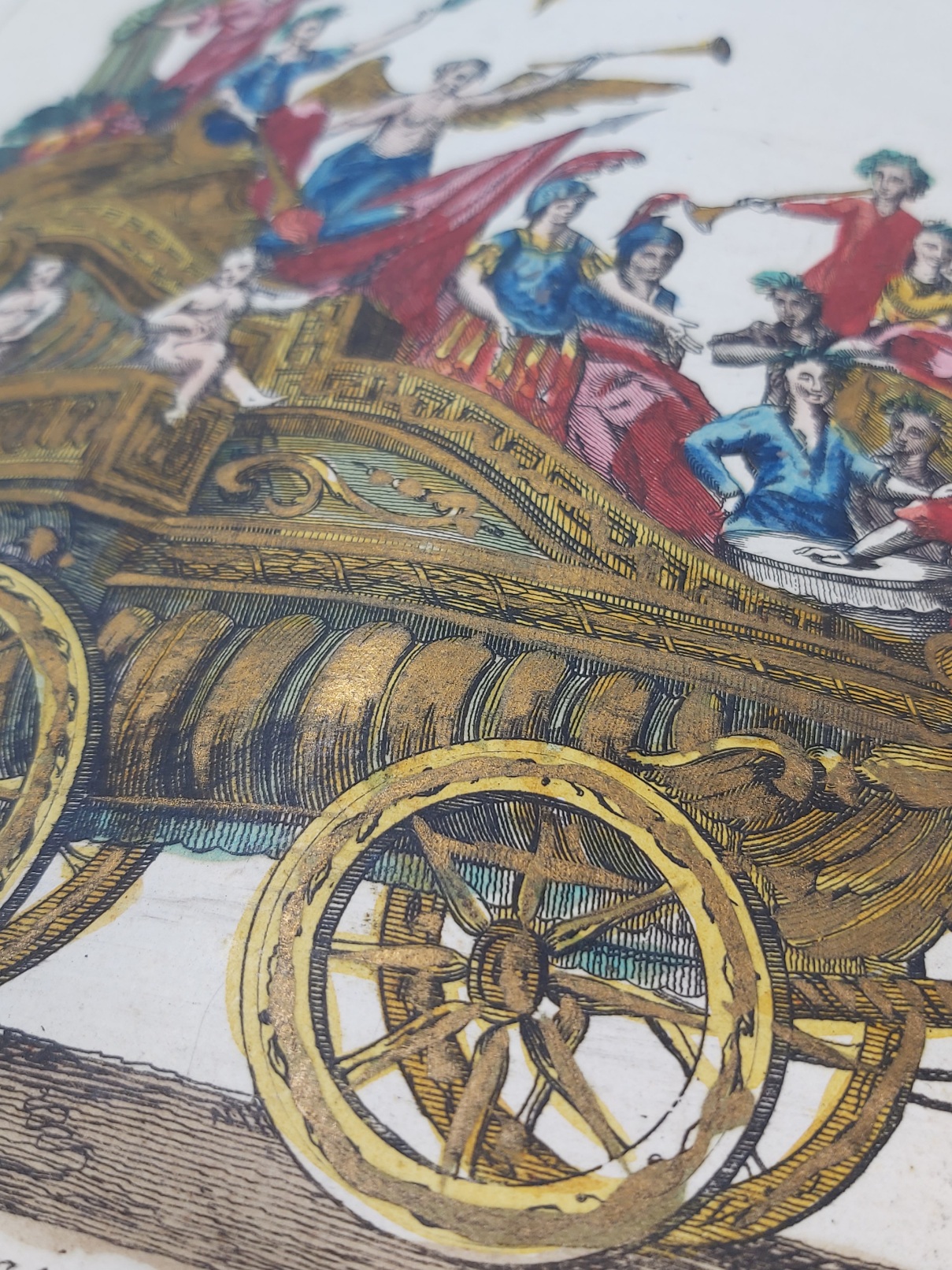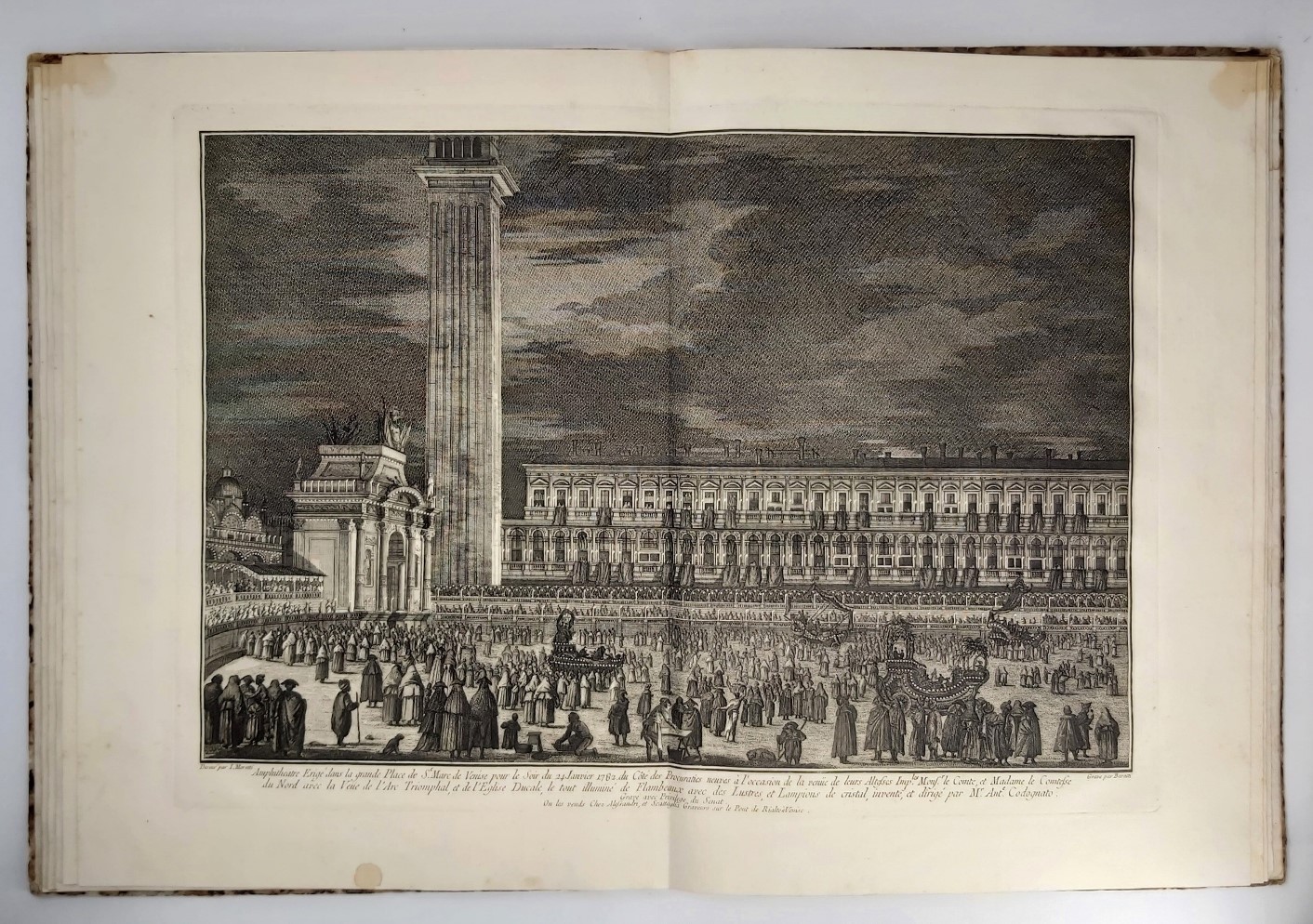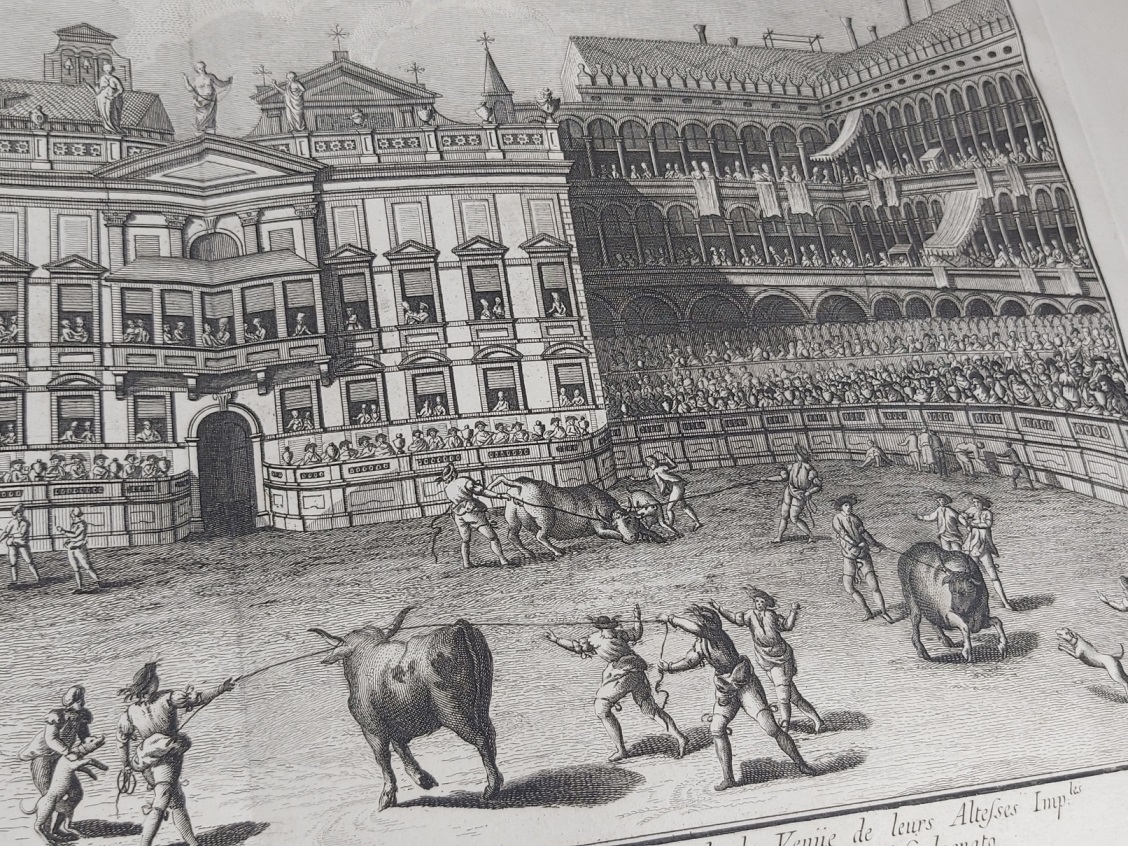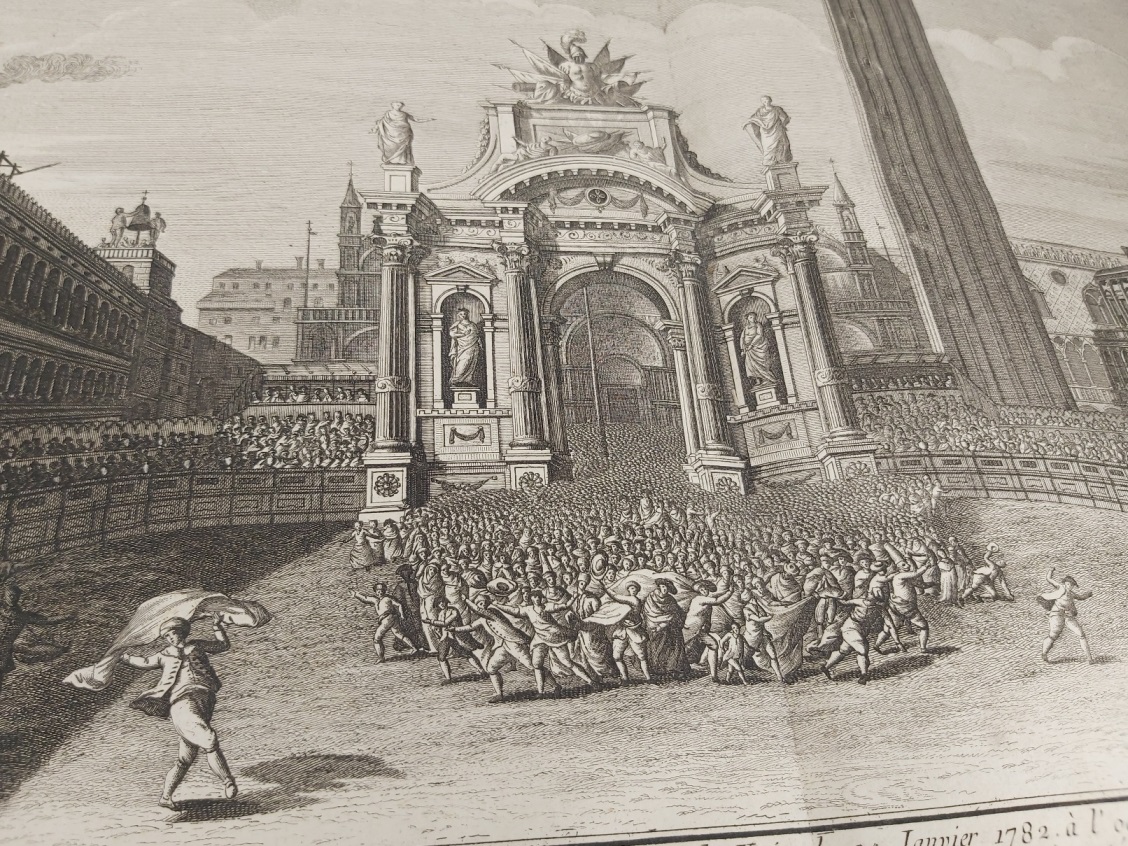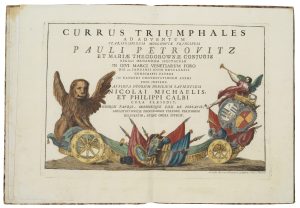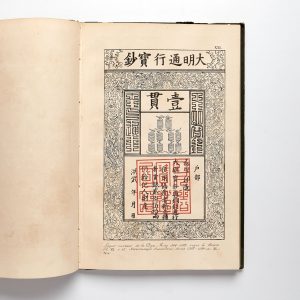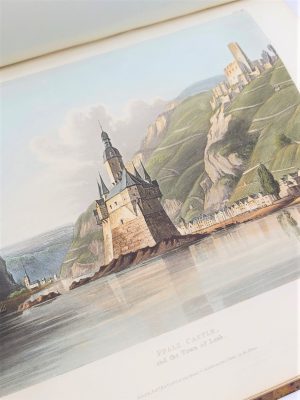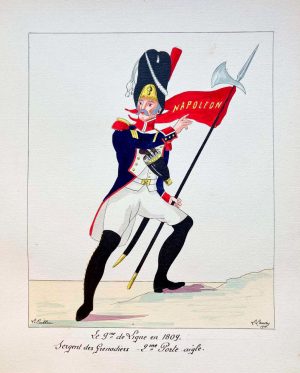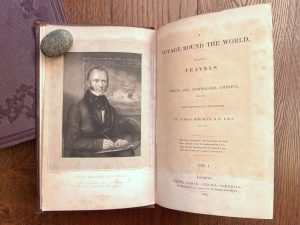Our Notes & References
Superb example of this festival book, very well preserved and with strong contemporary hand colouring, partially highlighted in gilt and silver.
First and only edition; bound with a lovely related suite by Baratti.
Very rare, especially in colour: we could locate only one -incomplete- copy at auction in recent decades. We found seven physical copies in libraries, but most seem to be in black and white: only two in the US (Beinecke Collection at Yale and Spencer Collection at NYPL), only one in Russia (RNB in St. Petersburg) and four in Europe: Piot Collection at the V&A Museum in London (like ours bound with four engravings by Baratti), Jacques Doucet Collection at Institut National d’Histoire de l’Art, Royal Library at Stockholm, and Universitätsbibliothek Göttingen.
In 1781, Catherine the Great sent her son, Grand Duke Pavel Petrovich (1754-1801), future Tsar Paul I, and his wife Maria Feodorovna (1759-1828) on a journey across the European continent for educational and diplomatic purposes. The Empress included in her programme of visits only those countries that she considered allies or potential friends of Russia, forbidding her son a long-awaited visit to Berlin and a meeting with the Prussian King Frederick the Great. The extensive journey lasted a bit more than a year, from September 1781 to November 1782, and followed a route from St Petersburg through Poland, Austria,Italy, France, Belgium and Holland to Maria Feodorovna’s native Duchy of Württemberg.
The travellers, referred to as the “Comte et Comtesse du Nord”, arrived in the Republic of Venice on 18 January 1782. To honour the royal guests, the local government organised a series of spectacular shows, including a regatta on the Grand Canal, a costumed carnival and a solemn procession of five allegorical chariots in St Mark’s Square; all the festivities culminated in a fireworks display on 24 January 1782.
The present suite of six engraved plates captures the extraordinary structures and decorations created for the procession under the direction of the architect and artist Domenico Fossati (1743-85), with the help of his father, the Swiss-born Italian architect Giorgio Fossati (1705-85). Each plate, “possibly by Jacopo Leonardis (1723-97)” (NYPL), portrays the movement of five allegorical “Currus triumphales”, or chariots of triumph. The first chariot represents “peace crowned with abundance” and hosts heralds of victory with trumpets and drums, soldiers, an angel proclaiming peace, and above all, allegorical images of peace in a laurel wreath and abundance with a basket full of fruit.
The second car celebrates the goddess of agriculture and fertility Ceres, and the third one represents Pan, the god of pastures, cattle breeding, forests and mountains, holding his signature flute with seven pipes to signify harmony. The fourth chariot carries the gods Athena (Pallade) and Mercury symbolising calculation, rationality, diplomacy and negotiation. On the lower tier of their car are wealthy merchants, one of whom in the centre gazes into his reflection as “a symbol of comprehension of truth” (Lepsky). The last chariot celebrates cross-national trade represented by people from different cultures. Each car, drawn by eight oxen in varying lavish decorations, has its own distinctive, intricate and detailed design, and hints at the aspirations of the Venetian state for fruitful diplomatic relations with Russia. Each plate looks particularly lively thanks to the bright contemporary hand colouring with touches of gilt and silver.
The second suite bound afterwards was engraved by Antonio Baratti (1724-87) after Carlo Grandi (2 plates) and I. Moretti (2 plates). It illustrates the amphitheatre-arena in which Fossati’s marvellous structures would have been viewed, and offers some very dark views of nightly Venice.
With admirable precision, one of the plates depicts a bullfighting, “la Chasse des Taureaux, inventé, et dirigé par M. Ant. Codognato”, at the Temporary Palace erected for the festivities. The palace crowns the arena spreading along the whole perimeter of St Mark’s Square; the local population views the performance from the windows around the arena with five wrestling bulls simultaneously. In the back right of the arena is even visible the injured toreador half-sitting against the wall, several staff members rushing to lift his hat and help him while the spectators watch with astonishment.
Another plate by Baratti shows a pompous triumphal arch letting a large dancing crowd through into the arena. Two other plates after Moretti convey night views from differing angles of the amphitheatre-arena, full of people in carnival costumes, some viewing Fossati’s chariots of triumph. These chariots, Triumphal Arch, the boards of the amphitheatre, and the surrounding buildings are nicely illuminated with crystal chandeliers and lanterns invented and designed by Codognato.
Some sources suggest that these plates by Baratti belong to a suite of six; however two other plates engraved by Baratti for the same occasion are different in style, have inscriptions in Latin and French instead of French only, and are of completely different dimensions: one plate engraved after Canaletto is 42.5 x 59 cm and another one after Fossati is 40 x 79.5 cm, while the four plates present here are roughly 29.3 x 41 cm (platemark).
Bibliography
Bobins IV, 1492; Cicogna. Saggio di Bibliografia Veneziana 1695; Watanabe-O’Kelly & Simon. Festivals and ceremonies, 1486; Thieme-Becker, XII, 239; Solove kat. 105, 308 for Baratti (also 4 plates; “rare sheets”) and 313 for Fossati (“rare edition” but only black and white); not in Ruggieri.
Ekaterina Dubrovskaia, “Blistatelnoe puteshestvie Pavla I i Marii Fedorovny” // Istoricheskii zhurnal, #11, 2007, pp. 50-65.
Maksim Lepskii, “Vizualnoe issledovanie venetsianskoi “mashiny triumfa” kak tekhnologii vlasti (na primere vizita grafov severnykh v ianvare 1782 goda)” // Zhurnal Ekspeditsiia, 11 July 2022.
Physical Description
Two works in one volume folio (35.6 x 26.2 cm). Pictorial double-page engraved title and 5 double-page plates by Domenico Fossati, of varying dimensions but roughly platemark 27.5 x 40 cm, all with contemporary hand-colour with gilt and silver additions; 4 double-page engraved plates by Baratti, of varying dimensions but roughly platemark 29.3 x 41 cm.
Binding
Contemporary Italian paper marbled boards, kept in a modern morocco-backed clamshell box with gilt lettering on the spine.
Condition
Extremities rubbed with small losses of paper, spine head and foot chipped, small areas of abrasion; only minor staining or soiling internally, mostly marginal or at verso of plates – a crisp example.






